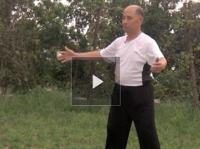I’ve been involved in the martial arts for quite some time, but when I arrived in Edmonton I vowed that I’d “empty my cup” as many martial arts are told to do when they come to train with another master.
Different teachers and martial art styles have different ways to achieve their desired effect. Many individuals have come to find that by not being rigid (in thought) and instead, being very open to different ideas and vantage-points, can help a practitioner gain a deeper level of mastery in the art. Throughout my study of martial arts [Shaolin White Crane Gongfu and Yang & Chen Style Taijiquan] I have developed an image of how a skilled martial artist would engage an opponent in combat. In Taijiquan, students are able to practice their development of Taiji principles and techniques found within the form and learn body sensitivity by a practice known as push hands.
In the past, I practiced push hand exercises in a very slow, patterned manner in which I would stand in a fixed, horse stance and focused on the elements of peng, lu, ji, and an in order to draw the other person off-balance. During my study with Master Chen Zhonghua I have come to understand that in order to be prepared for actual, realistic combat conditions, a martial artist should train in a variety of ways. This includes practicing with individuals of various sizes (height & weight), ages, experience and physical strengths (muscular strength/endurance, intelligence, etc.).
In order to be successful and to train successfully in push hands there are several elements you need to take into account. The following are elements and descriptions of the various aspects that should be practiced in order to gain skill in combat.
Mind-Intent: The central idea behind why we train in Taijiquan is to practice mind-intent. Movements of the form are practiced not for the sake of being slow, but for the sole purpose of training your mind to make connections with the rest of the body. Mind-intent is what is needed if a person is to react fluidly and quickly with exact precision.
Solid Foundation: Proper alignment of the body is essential in maintaining control of yourself and the opponent. One of the exercises that Master Chen stresses highly in practice is that of Taiji Circles (more description and images: T’ai Chi Journal, vol. 24.no. 3). According to Master Chen, “Positive and Negative Taiji circles are the basic building blocks of Taiji without which peng jin (energy) cannot be developed.” The proper execution of these circles are flawless and limitless in power. When all the joints of the body are moving in either a positive or negative circles the body becomes a vice which Grandmaster Feng Zhiqiang calls “The 18 balls of the body.” This ability is extremely difficult to achieve, but is perhaps the ultimate goal in Taiji practice.
Anatomical Weapons: Without structure and proper bodily shape the theory of “peng” cannot be completely expressed. According to Grandmaster Hong Junsheng, “Taijiquan is the art of peng. Peng is the result of the two circles.” In actual combat (and represented throughout the form) the arms should be arched and in direct accordance with the movements of the waist (creating a semi-circle or circle). The entire body should be moved as a whole and attacks should be made due to the various ranges between the two fighters.
Long-range attacks are made with the legs and hands, while close-range attacks (ideal position for taiji masters) utilize various locks (Chin Na)/ locking at 3 points [What Master Chen calls “Finding the line”], and elbow, shoulder and body strikes (i.e. bumping).
Mental Agility: Closely associated with mind-intent, a person’s mental agility can be best described as a person’s ability to think quickly and utilize his teachings and training on command. A person with good mental strength will also be better in combat due to his/her ability to better access a situation and take away the chance of fighting. A classic Chinese saying is, “the best fight is no fight.”
Spirit Energy, “Shen”: One of the three human treasures (Jing/Qi/Shen), “shen” is the spirit essence of a person. Legendary masters of the martial arts (one such person, GM Feng Zhiqiang) have been known to win confrontation with only a stare. Through someone’s motivation/determination, body language, and confidence, great battles can be won. A great Western example of “shen” can be found in the famous Rocky movies. Rocky Balboa, although at first a poor ameuter boxer, soon overcame the heavyweight champion Apollo Creed through sheer heart and determination. Physiological Tendencies: Although a person’s physiology encompasses a wide variety of avenues (i.e. physique, heart rate, ventilation, etc), the characteristic that is paramount is how the body reacts to stress. Under stressful circumstances, the human body can hyperventilate, “freeze,” and cause the a multitude of other hormonal and hematological disturbances within the body. When the mind and body is unbalanced, a person’s abilities and techniques are likely forfeited.
In combat you want stiffness (in regards to shape & structure), and softness, and continuity (without breaks in motion). Motions should also include fast and slow movements, loose and energetic movements, and springing attacks with whip-like speed. The body moves as one entity (around the dantian) and creates a gearbox in which power can be generated in limitless supply.
By: Michael Joyce
Jan.14th-Feb.1st::


